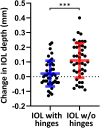Comparison of two one-piece acrylic foldable intraocular lenses: Short-term change in axial movement after cataract surgery and its effect on refraction
- PMID: 36040874
- PMCID: PMC9426912
- DOI: 10.1371/journal.pone.0273431
Comparison of two one-piece acrylic foldable intraocular lenses: Short-term change in axial movement after cataract surgery and its effect on refraction
Abstract
Purpose: To compare the change in intraocular lens (IOL) axial movement, corneal power, and postoperative refraction of eyes implanted with two different single-piece, open loop, acrylic foldable IOLs with planar-haptic design: one IOL with hinges vs. one IOL without hinges. The role of IOL axial movement on short-term refractive shift after cataract surgery was also evaluated.
Methods: This retrospective comparative study enrolled consecutive patients who had phacoemulsification with aspheric IOL implantation. The IOL depth (the distance from corneal endothelium to IOL surface) and corneal power were measured via anterior-segment optical coherence tomography at 4 days and 1 month postoperatively. The changes in axial movement of the IOL, corneal power, and manifest refractive spherical equivalent (MRSE) were compared among groups, and the correlations between each lens were evaluated.
Results: IOL with hinges was implanted in 42 eyes of 42 patients and IOL without hinges was implanted in 42 eyes of 42 patients. The change in axial movement between 4 days and 1 month was significantly smaller in the IOL with hinges group than in the IOL without hinges group (p < 0.001). The axial movement of IOL with hinges did not correlate with the MRSE change; however, the forward shift of IOL without hinges correlated with the myopic refractive change (Pearson r = 0.62, p < 0.001).
Conclusion: The postoperative axial movement of IOL was more stable in the IOL with hinges group than the IOL without hinges group between 4 days and 1 month after cataract surgery. Even though the two study IOLs with planar-haptic design are made of similar acrylic materials, other characteristics such as hinge structure may affect IOL stability in the bag.
Conflict of interest statement
SG is supported by Grants Manpei Suzuki Diabetic Foundation and Japan Society for the Promotion of Science Overseas Research Fellowships that are not related to the submitted work. SG, NM, and TN received honoraria for speaking outside the submitted work from Alcon Japan Ltd. These do not alter our adherence to PLOS ONE policies on sharing data and materials. There are no patents, products in development or marketed products to declare.
Figures




References
-
- Olsen T. Calculation of intraocular lens power: a review The statistical. Acta Ophthalmol Scand. 2007;472–85. - PubMed
Publication types
MeSH terms
LinkOut - more resources
Full Text Sources
Medical

